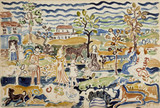Often referred to as America’s first postimpressionist, Maurice Brazil Prendergast developed his own modern idiom. During the 1890s he achieved recognition for his watercolors and monotypes. Working in Boston, he developed a watercolor style in which color and light vibrate and dance over the paper. Around 1903-4 Prendergast increasingly painted in oils. His dominant theme remained constant: figures parading along a beach or a city street or in a park. Only in the twentieth century did Prendergast occasionally paint still-life compositions.
His first documented trip to Europe was undertaken with his lifelong companion, his brother Charles (1868-1948), in 1891. Maurice studied intermittently at the Académie Julian and Atelier Colarossi in Paris, but his most important teachers were his friends the painters James Wilson Morrice (1865-1924) and Charles Conder (1868-1909). The
paintings of the impressionists, neoimpressionists, and symbolists, which he saw in Paris, also influenced his artistic development.
Returning to Boston in 1895, Prendergast supported himself by illustrating books and with the assistance of his brother. At this time he began exhibiting outside Boston. From 1898 to 1900 he lived in Europe, both in France and in Italy, where he created his well’ known, brilliantly luminous watercolors of Venice. In early 1900 the Macbeth Gallery, New York, began selling his work, and in 1908 he participated in the gallery’s landmark exhibition of The Eight. In 1914 he moved to New York. His third trip to Paris, taken after the exhibition of The Eight, exposed him to more modern art, in particular the late work of Paul Cézanne (1839-1906) and the art of the fauves. In late 1911 and 1914 he again traveled abroad.
Although his early watercolors have often been referred to as impressionist, Prendergast abandoned the concern with nature to concentrate on the pictorial design of a painting. His art became nonreferential as he began to create a personal language. By using a limited range of subjects in serial fashion, he focused exclusively on formal elements of line and color. He also became more aware of the sensuous qualities of paint. Colors are juxtaposed and brush strokes broken to create perfectly harmonious, rhythmic arrangements.
BIBLIOGRAPHY
Margaret Breuning, Maurice Prendergast, American Artists Series (New York: Whitney Museum of American Art, 1931), with biographical note by Edmund Archer, bibliography § Boston, Museum of Fine Arts, and others, Maurice Prendergast, 1859-1924, exh. cat., 1960, published by Harvard University Press, Cambridge, Mass., by Hedley Howell Rhys, with catalogue by Peter A. Wick, chronology, bibliography § College Park, University of Maryland Art Gallery, and others, Maurice Prendergast, exh. cat., 1976, with essay by Eleanor Green, chronology by Green and Ellen Glavin, catalogue by Green and Jeffrey R. Hayes § Cecily Langdale, Monotypes by Maurice Prendergast in the Terra Museum of American Art (Evanston, Ill.: Terra Museum of American Art, 1984), with bibliography § Carol Clark, Nancy Mowll Mathews, and Wendy Owens, Maurice and Charles Prendergast: A Systematic Catalogue, ed. Milton W. Brown (forthcoming, Prestel-Verlag, Munich), with bibliography, list of exhibitions.

